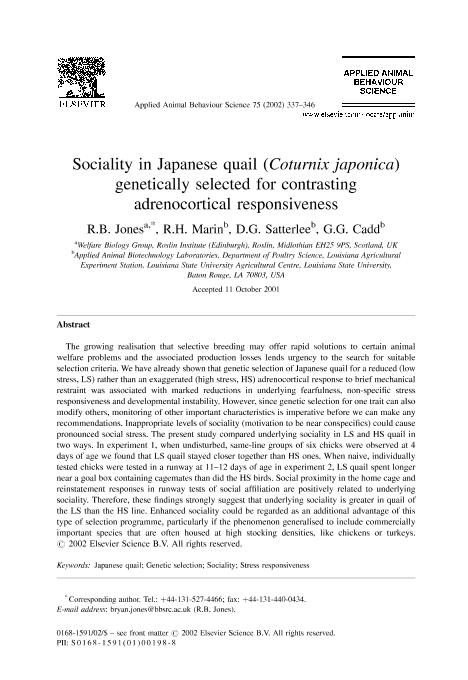Mostrar el registro sencillo del ítem
dc.contributor.author
Jones, R.B.
dc.contributor.author
Marin, Raul Hector

dc.contributor.author
Satterlee, D. G.
dc.contributor.author
Cadd, G. G.
dc.date.available
2018-11-14T15:03:31Z
dc.date.issued
2002-02-04
dc.identifier.citation
Jones, R.B.; Marin, Raul Hector; Satterlee, D. G.; Cadd, G. G.; Sociality in Japanese quail (Coturnix japonica) genetically selected for contrasting adrenocortical responsiveness; Elsevier Science; Applied Animal Behaviour Science; 75; 4; 4-2-2002; 337-346
dc.identifier.issn
0168-1591
dc.identifier.uri
http://hdl.handle.net/11336/64467
dc.description.abstract
The growing realisation that selective breeding may offer rapid solutions to certain animal welfare problems and the associated production losses lends urgency to the search for suitable selection criteria. We have already shown that genetic selection of Japanese quail for a reduced (low stress, LS) rather than an exaggerated (high stress, HS) adrenocortical response to brief mechanical restraint was associated with marked reductions in underlying fearfulness, non-specific stress responsiveness and developmental instability. However, since genetic selection for one trait can also modify others, monitoring of other important characteristics is imperative before we can make any recommendations. Inappropriate levels of sociality (motivation to be near conspecifics) could cause pronounced social stress. The present study compared underlying sociality in LS and HS quail in two ways. In experiment 1, when undisturbed, same-line groups of six chicks were observed at 4 days of age we found that LS quail stayed closer together than HS ones. When naive, individually tested chicks were tested in a runway at 11-12 days of age in experiment 2, LS quail spent longer near a goal box containing cagemates than did the HS birds. Social proximity in the home cage and reinstatement responses in runway tests of social affiliation are positively related to underlying sociality. Therefore, these findings strongly suggest that underlying sociality is greater in quail of the LS than the HS line. Enhanced sociality could be regarded as an additional advantage of this type of selection programme, particularly if the phenomenon generalised to include commercially important species that are often housed at high stocking densities, like chickens or turkeys. © 2002 Elsevier Science B.V. All rights reserved.
dc.format
application/pdf
dc.language.iso
eng
dc.publisher
Elsevier Science

dc.rights
info:eu-repo/semantics/openAccess
dc.rights.uri
https://creativecommons.org/licenses/by-nc-sa/2.5/ar/
dc.subject
Genetic Selection
dc.subject
Japanese Quail
dc.subject
Sociality
dc.subject
Stress Responsiveness
dc.subject.classification
Biología

dc.subject.classification
Ciencias Biológicas

dc.subject.classification
CIENCIAS NATURALES Y EXACTAS

dc.title
Sociality in Japanese quail (Coturnix japonica) genetically selected for contrasting adrenocortical responsiveness
dc.type
info:eu-repo/semantics/article
dc.type
info:ar-repo/semantics/artículo
dc.type
info:eu-repo/semantics/publishedVersion
dc.date.updated
2018-11-12T13:45:05Z
dc.journal.volume
75
dc.journal.number
4
dc.journal.pagination
337-346
dc.journal.pais
Países Bajos

dc.journal.ciudad
Amsterdam
dc.description.fil
Fil: Jones, R.B.. Roslin Institute; Estados Unidos
dc.description.fil
Fil: Marin, Raul Hector. Consejo Nacional de Investigaciones Científicas y Técnicas; Argentina. State University of Louisiana; Estados Unidos
dc.description.fil
Fil: Satterlee, D. G.. State University of Louisiana; Estados Unidos
dc.description.fil
Fil: Cadd, G. G.. State University of Louisiana; Estados Unidos
dc.journal.title
Applied Animal Behaviour Science

dc.relation.alternativeid
info:eu-repo/semantics/altIdentifier/url/https://www.sciencedirect.com/science/article/pii/S0168159101001988
dc.relation.alternativeid
info:eu-repo/semantics/altIdentifier/doi/https://dx.doi.org/10.1016/S0168-1591(01)00198-8
Archivos asociados
